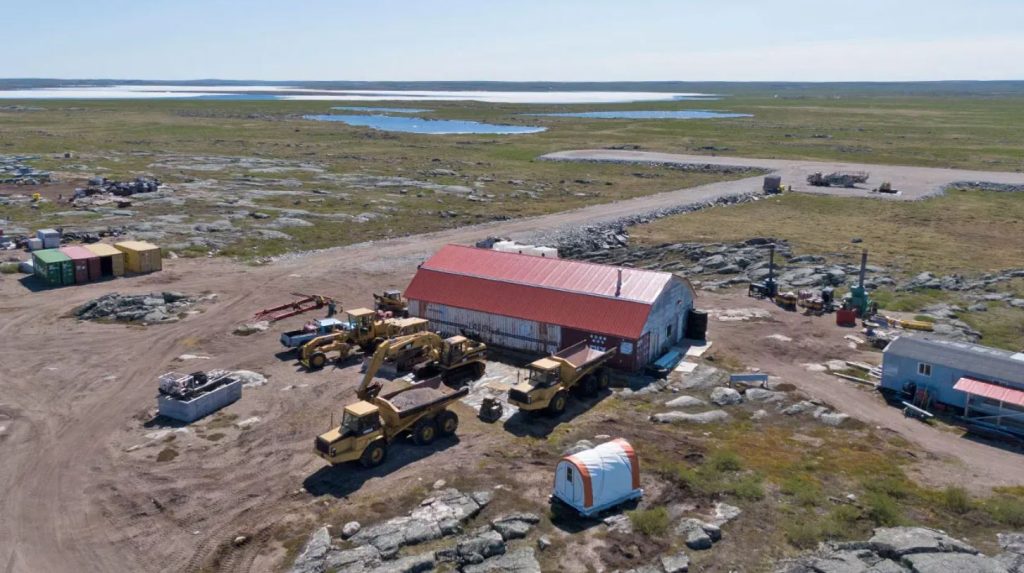Canadian North Resources drills 0.89% copper over 10 metres at Ferguson Lake, Nunavut

Canadian North Resources Inc. [CNRI-TSXV; EO0 (E-O-zero) FSE]] reported assay results for the 6,151 metres in 21 holes of diamond drilling completed during the spring at its 100%-owned Ferguson Lake project in Nunavut, northern Canada. The Ferguson Lake project contains base metals (nickel, copper and cobalt) and platinum group metals (PGM, mainly palladium and platinum), as well as potentially lithium minerals, along a 15-km-long main mineralized horizon and numerous additional prospective areas.
Highlights: Completed resource definition drilling on the east extension (an area of 1,200 m by 100 to 250 m) of West zone and the west extension (an area of 1,500 m by 100 to 300 m) of East zone.
Highlighted new assay results: 10.0 metres (from 47.57 to 57.57 m) at 0.89% Cu, 0.53% Ni, 0.08% Co, 1.05 g/t Pd, 0.12 g/t Pt and 0.02 g/t rhodium (hole FL23-504A); 5.0 metres (from 84.5 to 89.5 m) at 0.83% Cu, 0.34% Ni, 0.04% Co, 0.78g/t Pd, 0.12 g/t Pt, 0.01 g/t Rh; 5.0 metres (from 119 to 124 m) at 0.32% Cu, 0.83% Ni, 0.12% Co, 1.22 g/t Pd, 0.19 /t Pt, 0.02 g/t Rh (hole FL23-515); 14.0 metres (from 16.99 to 30.99 m) at 0.32% Cu, 0.39% Ni, 0.05% Co, 0.65g/t Pd, 0.16 g/t Pt, 0.02 g/t Rh (hole FL23-501); 5.0 m (from 87.5-92.5 m) at 0.61 per cent Cu, 0.83 per cent Ni, 0.07% Co, 1.07 g/t Pd, 0.17 g/t Pt, 0.01 g/t Rh (hole FL23-521).
Five drill rigs are currently operating to complete the planned 20,000-metre drill program in 2023, of which 11,723 metres in 37 holes have been drilled to date.
“The spring on-ice drilling program further confirmed the main mineralized horizon trending across Ferguson Lake,” said Dr. Kaihui Yang, the president and CEO of exploration. “With this and the spring drilling programs in 2022, we have completed definition drilling of the west extension of East zone, for an area of 1,500 metres by 100 to 300 metres, and the east extension of West zone, for an area of 1,200 metres by 100 to 250 metres. Those near-surface mineralization zones will add significant new or up-graded resources to the current mineral resource estimates.
“With five drill rigs operating in the field, the company is continuing its planned 20,000-metre drill program in 2023,” said Dr. Trevor Boyd, the vice-president for exploration of the company. “We are focusing on primarily expanding and upgrading the near-surface mineral resources of the West and East zones; defining the potential new near-surface resources along subparallel M-Zone and A51 zone; and testing the new targets along the east extensions of the East zone and A51 zone, West zone south and South Discovery zone.”
The 2023 spring drill program intersected near-surface massive sulphides (over 2.0 metres) of the main horizon in 16 out of the 21 holes along the West zone extension and East zone across the Ferguson Lake. It successfully intersected a second parallel trending disseminated sulphide zone approximately 200 metres south of the Central zone. This encouraging second zone has been identified as a separate target from the compilation and replotting of an interpreted historic airborne versatile time domain electromagnetic system conductor. The assay results show this second zone is PGM enriched, which is comparable and correlated with the deep PGM mineralization in the West zone.
East extension of West zone: The company has drilled 18 holes on ice, including nine holes completed in 2023 spring and nine holes in 2022 spring, for infill and expansion of the east extension of the West zone connecting to the Central zone. These drill holes confirmed and expanded the mineralized zones as indicated in the historic 34 holes. With the total of 52 drill holes, the east extension of the West zone is well defined for 1,200 metres by 100 to 250 metres.
West extension of East zone: A total of 20 holes on ice, including 12 holes completed in 2023 spring and eight holes in 2022 spring, have been drilled by the company to infill and expand the west extension of the East zone. These holes confirmed the near-surface mineralized intersections by the historic holes. These holes, together with 46 historic holes, well define the west extension of the East zone for an area of 1,500 metres by 100 to 300 metres.
In addition to drilling, the company is carrying out in-hole geophysical surveys, surface sampling and mapping programs on the Ni-Cu-Co-Pd-Pt and lithium targets over the 253.8 km2 of mining leases and exploration claims at the Ferguson Lake property.
Canadian North Resources is advancing its 100%-owned Ferguson Lake nickel, copper, cobalt, palladium and platinum project that covers an area of 253.8 km2 of mining leases (96.9 km2) and surrounding exploration claims (156.9 square km) in the Kivalliq region of Nunavut.
The Ferguson Lake mining property contains substantial NI 43-101 resources, which include indicated mineral resources of 24.3 million tonnes containing 455 million pounds copper at 0.85 %, 321 million lb nickel at 0.60%, 37.5 million lb cobalt at 0.07%, 1.08 million ounces (oz) palladium at 1.38 g/t and 180,000 oz platinum at 0.23 g/t; inferred mineral resources of 47.2 million tonnes containing 947 million lb copper at 0.91%, 551.5 million lb nickel at 0.53%, 62.4 million lb cobalt at 0.06%, 2.12 million oz palladium at 1.4 g/t and 380,000 oz platinum at 0.25 g/t. The resource model indicates significant potential for resource expansion along strike and at depth over the 15 km long mineralized belt.
